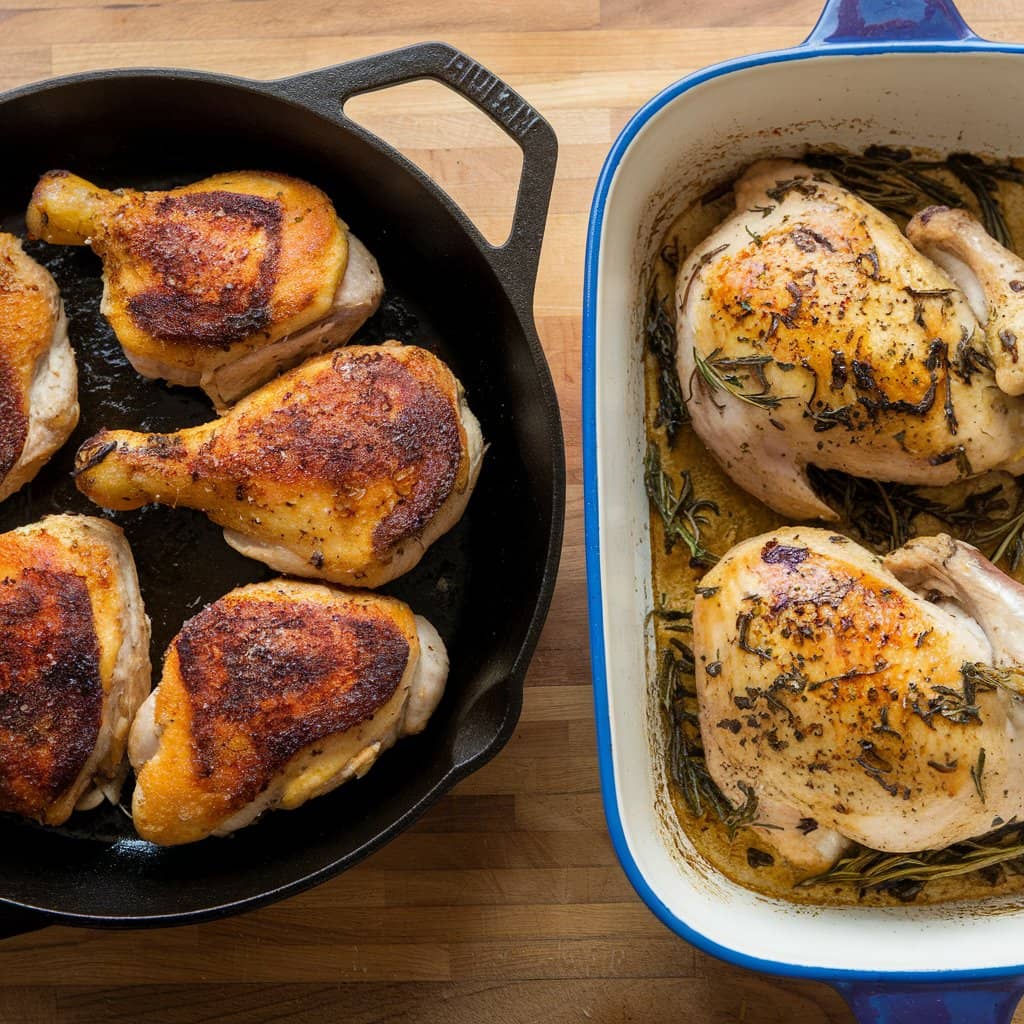When deciding how to cook chicken, many wonder, “Is chicken better in the skillet or the oven?” Both methods offer unique advantages, but the best choice depends on your cooking goals. This guide will explore the differences, benefits, and best recipes for each method to help you determine whether chicken is better in the skillet or the oven.chicken dish.
Table of contents
Cooking Chicken in a Skillet
Techniques for Cooking Chicken in a Skillet
Cooking chicken in a skillet is a popular method for achieving a crispy, golden-brown exterior while keeping the meat juicy inside. Here’s how to master skillet-cooked chicken:
- Preheating the Skillet: Use a heavy-bottomed skillet, such as cast iron, and preheat it over medium-high heat. This ensures even cooking.
- Using the Right Oil: Choose oils with a high smoke point, like vegetable or avocado oil, to prevent burning.
- Seasoning the Chicken: Season both sides of the chicken with salt, pepper, and spices of your choice.
- Cooking Process: Sear the chicken for 4-5 minutes on each side. Avoid moving the chicken too soon to allow a crispy crust to form.
- Internal Temperature Check: Use a meat thermometer to ensure the chicken reaches 165°F (75°C).
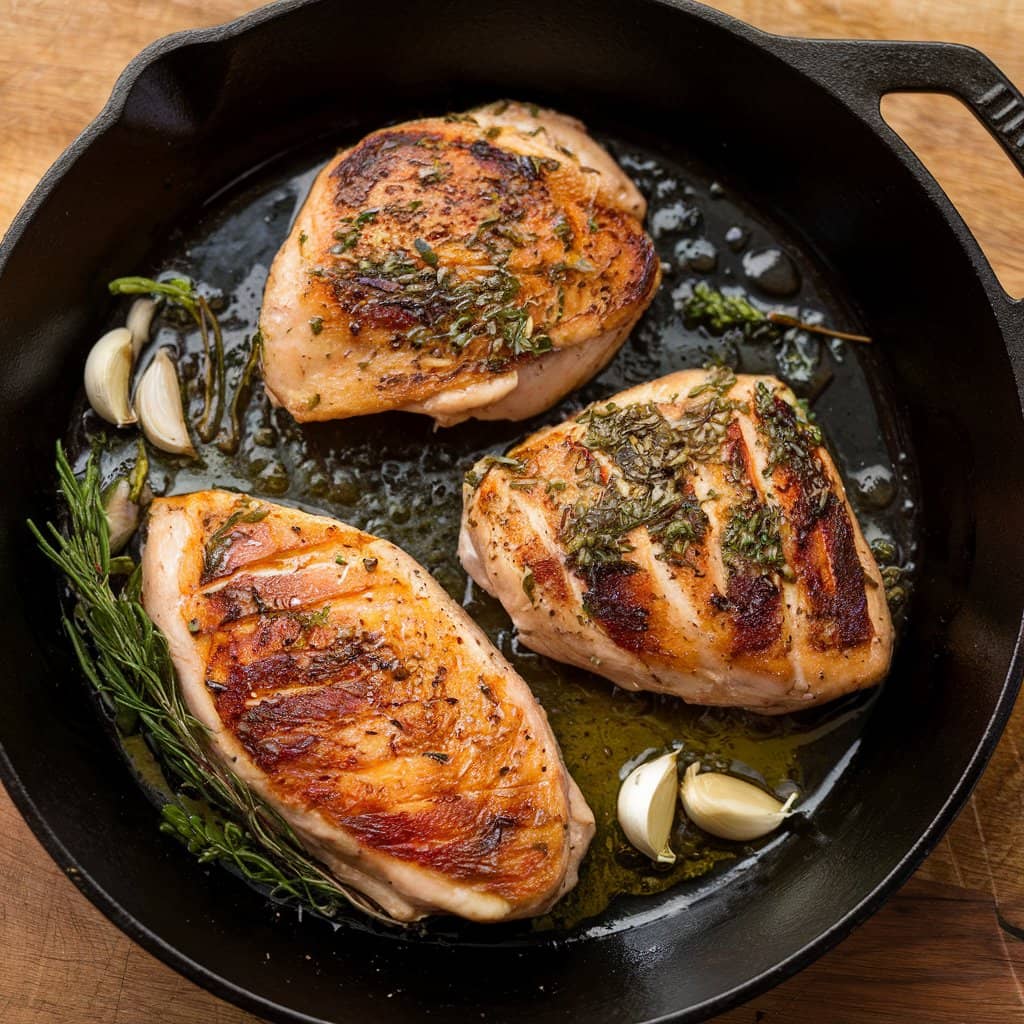
Advantages of Cooking Chicken in a Skillet
- Quick Cooking Time: Chicken cooks faster in a skillet due to direct heat.
- Crispy Texture: Skillet cooking creates a crisp, caramelized crust.
- Flavor Development: Browning the chicken enhances its savory taste through the Maillard reaction.
Limitations of Cooking Chicken in a Skillet
- Uneven Cooking: Thick cuts may cook unevenly if not managed properly.
- Potential for Dryness: Overcooking can cause the chicken to dry out.
- Oil Splatter: High-heat searing can cause oil splatter, requiring cleanup.
Cooking Chicken in the Oven
Techniques for Cooking Chicken in the Oven
Oven cooking is a popular method for preparing chicken, especially for larger portions or whole birds. Here’s how to ensure your chicken turns out perfectly roasted:
- Preheating the Oven: Set the oven to the recommended temperature, typically between 375°F and 425°F, depending on the recipe.
- Preparing the Chicken: Pat the chicken dry with paper towels and season thoroughly with salt, pepper, herbs, and spices.
- Choosing the Right Pan: Use a roasting pan or baking sheet with a rack to allow airflow for even cooking.
- Cooking Process: Place the chicken in the oven, skin-side up for cuts like thighs or breasts. Roast until the internal temperature reaches 165°F (75°C).
- Resting the Chicken: Let the chicken rest for 5-10 minutes after removing it from the oven to retain its juices.
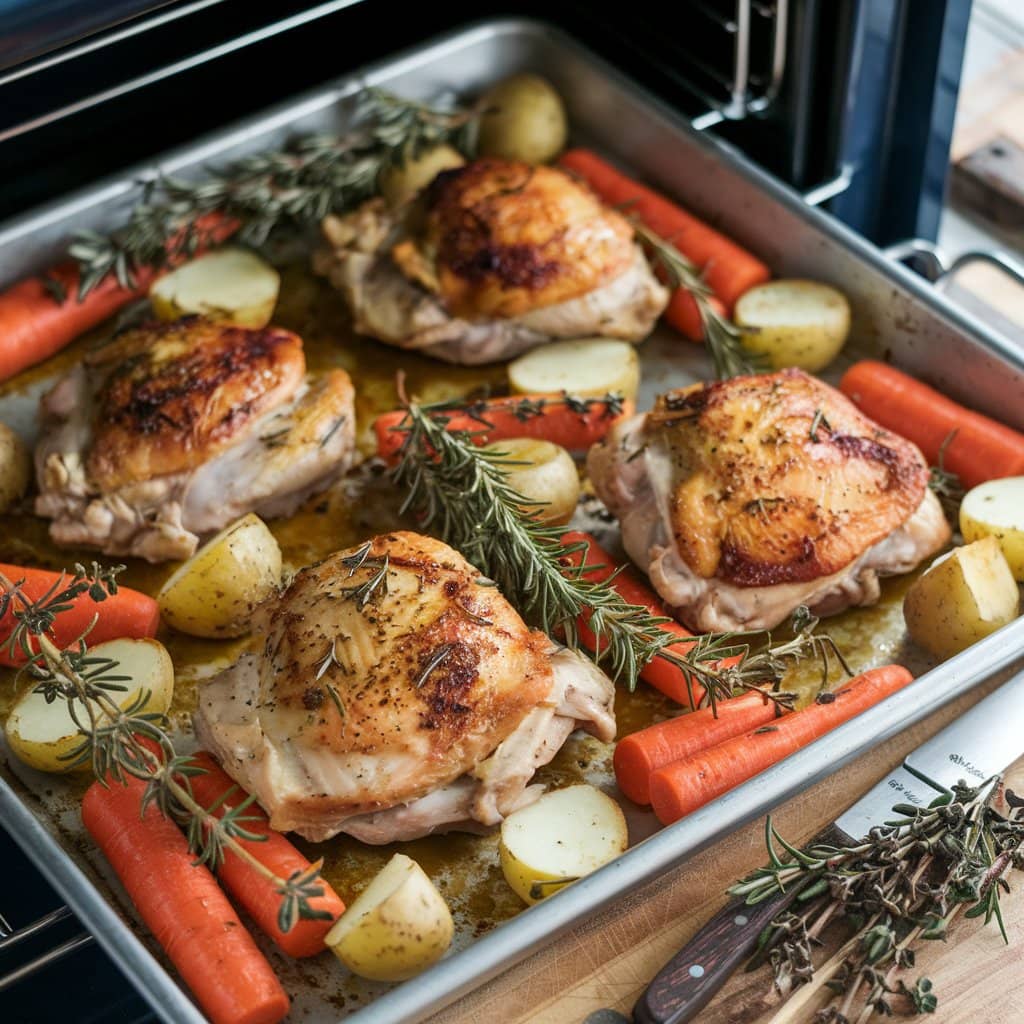
Advantages of Cooking Chicken in the Oven
- Even Cooking: Heat circulates evenly, ensuring thorough cooking.
- Hands-Off Method: Once in the oven, minimal monitoring is needed.
- Healthier Option: Less oil is required compared to skillet cooking.
- Batch Cooking: Ideal for preparing large quantities at once.
Limitations of Cooking Chicken in the Oven
- Longer Cooking Time: Oven roasting takes more time than skillet cooking.
- Less Crispiness: Unless broiled, the skin may be less crispy.
- Potential Dryness: Overcooking can lead to dry meat if not monitored.
Comparing Skillet vs. Oven-Cooked Chicken
Flavor Comparison
- Skillet-Cooked Chicken: Known for its rich, savory flavor due to caramelization during searing. The crispy crust created in the skillet intensifies the chicken’s taste.
- Oven-Cooked Chicken: Offers a more even, well-rounded flavor, especially when seasoned with herbs and roasted with vegetables. While the skin can be crispy when broiled, it is usually softer.
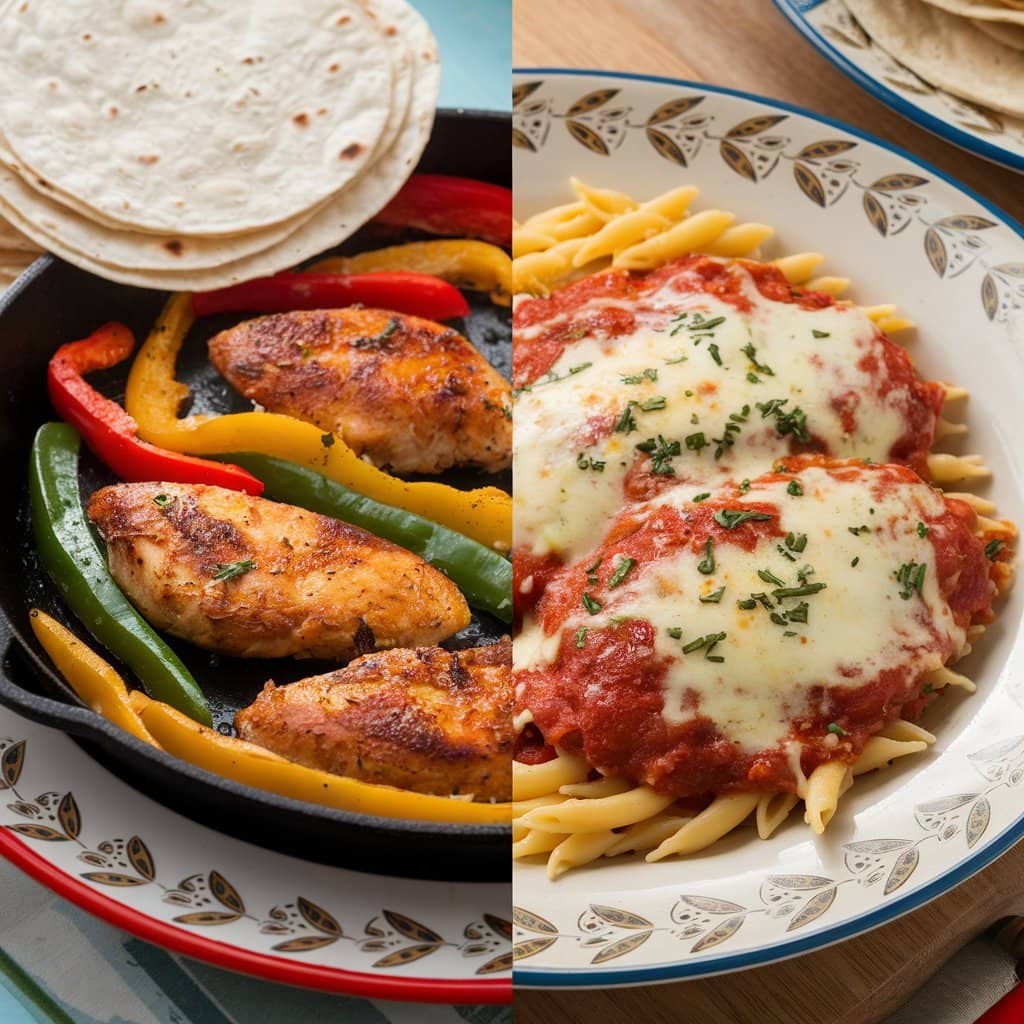
Texture Comparison
- Skillet-Cooked Chicken: Crispy on the outside with a juicy interior when cooked properly. The direct heat creates a satisfying crunch, especially for boneless cuts.
- Oven-Cooked Chicken: Moist and tender, especially when roasted with the skin on or using a covered dish. The meat remains juicy due to slower cooking at moderate temperatures.
Nutrition Comparison
- Skillet-Cooked Chicken: Typically requires more oil, increasing fat content. However, using non-stick or well-seasoned cast-iron skillets can reduce the oil needed.
- Oven-Cooked Chicken: Generally considered healthier due to minimal oil use. It’s ideal for low-fat and low-calorie meal preparation.
Versatility and Convenience
- Skillet-Cooked Chicken: Best for quick, single-serving meals or small portions. It’s suitable for stovetop recipes that include sauces or gravies.
- Oven-Cooked Chicken: Great for large meals, meal prep, and family dinners. Its hands-off approach makes multitasking easier while cooking.
Cooking Time and Effort
- Skillet-Cooked Chicken: Faster cooking time but requires active monitoring and flipping.
- Oven-Cooked Chicken: Longer cooking time but minimal attention needed once it’s in the oven.
Best Recipes for Skillet-Cooked Chicken
1. Pan-Seared Chicken Breast
- Ingredients: Boneless, skinless chicken breasts, olive oil, salt, pepper, garlic powder, and paprika.
- Cooking Method: Sear the seasoned chicken breasts in a hot skillet for 6-7 minutes on each side until golden brown. Serve with a side of vegetables or a fresh salad.
2. Chicken Piccata
- Ingredients: Chicken cutlets, flour, lemon juice, capers, chicken broth, and butter.
- Cooking Method: Coat the chicken in flour and sear until golden brown. Add a lemon-butter-caper sauce and simmer for 5 minutes. This Italian favorite pairs well with pasta or mashed potatoes.
3. Garlic Butter Chicken Thighs
- Ingredients: Bone-in, skin-on chicken thighs, butter, garlic, thyme, and rosemary.
- Cooking Method: Sear the seasoned thighs skin-side down until crispy, then flip and cook through. Add garlic and herbs, basting the chicken with the flavorful butter sauce.
4. Honey Garlic Chicken Bites
- Ingredients: Boneless chicken thighs or breasts, soy sauce, honey, garlic, and red pepper flakes.
- Cooking Method: Sear bite-sized chicken pieces until browned. Add a honey-garlic sauce and simmer until thickened. Serve over rice or noodles for a sweet-savory meal.
5. Chicken Fajitas
- Ingredients: Chicken strips, bell peppers, onions, fajita seasoning, and tortillas.
- Cooking Method: Sear the seasoned chicken in a hot skillet until cooked. Add bell peppers and onions, cooking until tender. Serve with warm tortillas, salsa, and guacamole.
Best Recipes for Oven-Cooked Chicken
1. Classic Roast Chicken
- Ingredients: Whole chicken, olive oil, salt, pepper, garlic, rosemary, and lemon.
- Cooking Method: Season the chicken inside and out. Stuff the cavity with lemon and garlic, then roast at 425°F for 1.5 hours or until golden brown and fully cooked. Serve with roasted vegetables.
2. Baked Chicken Parmesan
- Ingredients: Chicken breasts, breadcrumbs, marinara sauce, mozzarella, and Parmesan cheese.
- Cooking Method: Bread the chicken breasts and bake at 400°F for 25-30 minutes. Top with marinara and cheese during the last 10 minutes of cooking for a delicious Italian-inspired meal.
3. Lemon Herb Chicken Thighs
- Ingredients: Bone-in, skin-on chicken thighs, lemon juice, garlic, thyme, and rosemary.
- Cooking Method: Marinate the thighs in lemon herb sauce, then bake at 400°F for 35-40 minutes until crispy and fully cooked. Great with rice or quinoa.
4. BBQ Baked Chicken
- Ingredients: Chicken drumsticks or thighs, BBQ sauce, salt, and pepper.
- Cooking Method: Season the chicken, coat with BBQ sauce, and bake at 375°F for 45-50 minutes, basting with extra sauce every 15 minutes for a sticky, flavorful finish.
5. Oven-Baked Chicken Wings
- Ingredients: Chicken wings, baking powder, salt, pepper, and your favorite wing sauce.
- Cooking Method: Toss wings in baking powder and seasonings. Bake at 425°F for 45 minutes, flipping halfway through. Coat with wing sauce and serve with dipping sauces.
Choosing the Right Cooking Method Based on Your Goals
When to Choose Skillet-Cooked Chicken
Skillet cooking is best when you want:
- Quick Meals: If you’re pressed for time, a skillet ensures faster cooking.
- Crispy Texture: For crispy, seared skin or crust, the skillet is unmatched.
- Saucy Dishes: Recipes like chicken Marsala, piccata, or fajitas work well.
- Small Portions: Great for cooking 1-4 servings with minimal cleanup.
When to Choose Oven-Cooked Chicken
Oven cooking is ideal when you need:
- Large Portions: Great for batch cooking or family dinners.
- Even Cooking: The heat surrounds the chicken for consistent results.
- Hands-Off Cooking: Minimal monitoring required once in the oven.
- Meal Prep: Bake several pieces at once for meal prep or leftovers.
Common Cooking Mistakes to Avoid
Skillet Cooking Mistakes
- Overcrowding the Pan: Leads to steaming rather than searing.
- Using the Wrong Oil: Avoid low smoke-point oils like butter alone.
- Skipping Preheating: A cold skillet prevents proper searing.
- Moving the Chicken Too Early: This can tear the skin or crust.
Oven Cooking Mistakes
- Not Preheating the Oven: Skipping this step affects cooking time and texture.
- Cooking at the Wrong Temperature: Too low leads to undercooked chicken; too high can dry it out.
- Skipping Resting Time: Let the chicken rest after cooking to retain juices.
- Not Using a Meat Thermometer: This ensures the chicken is fully cooked and safe to eat.
Essential Tools for Cooking Chicken
Tools for Skillet Cooking
- Cast-Iron Skillet: Retains heat and ensures even cooking.
- Tongs: For flipping chicken without piercing the meat.
- Splatter Screen: Reduces mess from hot oil splatter.
- Meat Thermometer: Ensures chicken is cooked to 165°F (75°C).
Tools for Oven Cooking
- Roasting Pan: Allows even cooking and holds large portions.
- Baking Sheet with Rack: Promotes airflow for crispy skin.
- Aluminum Foil or Parchment Paper: Prevents sticking and makes cleanup easier.
- Basting Brush: Helps apply sauces or marinades evenly.
Tips for Perfect Chicken Every Time
Prepping the Chicken
- Brining: Soaking in salted water boosts moisture retention.
- Marinating: Adds flavor and tenderizes the meat.
- Patting Dry: Removes excess moisture for better browning.
Cooking Techniques
- Searing First: Lock in juices by searing before baking.
- Monitoring Temperature: Use a thermometer to avoid overcooking.
- Basting Frequently: Keeps chicken moist during long cooking times.
Why Cooking Method Matters
Impact on Taste and Texture
- Skillet: More intense flavors with a caramelized crust.
- Oven: Balanced flavors with tender, juicy meat.
Impact on Health
- Skillet: May require more oil, adding calories.
- Oven: Healthier due to less oil and fat rendering.
Frequently Asked Questions (FAQs)
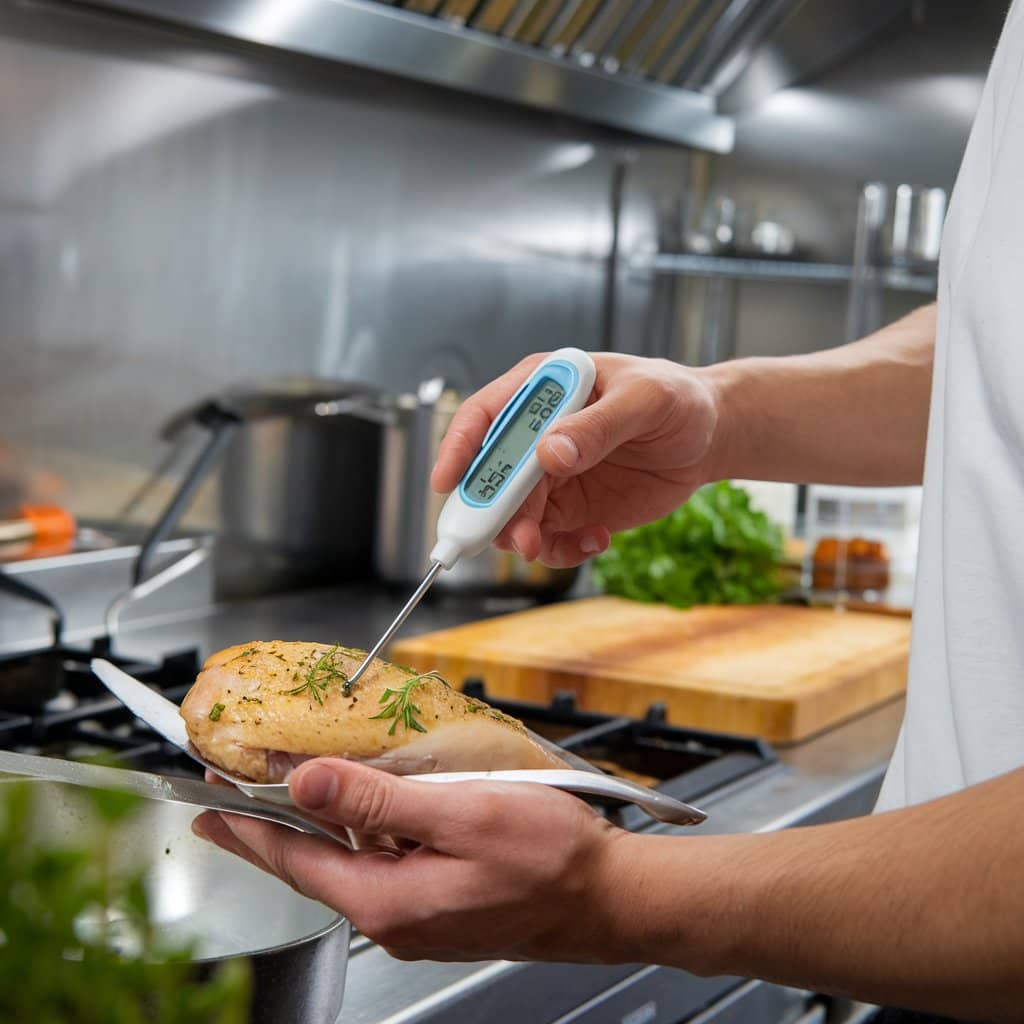
1. Which Is Healthier: Skillet or Oven-Cooked Chicken?
Oven-cooked chicken is generally healthier because it requires less oil. Skillet-cooked chicken can also be healthy if cooked with minimal oil and without heavy sauces.
2. Can You Use Both Methods for One Recipe?
Yes, many recipes start with searing chicken in a skillet to build a crispy crust and finish cooking in the oven for even doneness. This method is common in dishes like skillet-roasted chicken thighs.
3. How Do You Prevent Chicken from Drying Out in the Oven?
To avoid dry chicken, marinate it before baking, cover it with foil, or bake it with moisture-rich ingredients like broth, vegetables, or sauces. Use a meat thermometer to avoid overcooking.
4. How Do You Ensure Crispy Skin When Baking Chicken?
Pat the chicken dry, season generously, and bake at a high temperature (400°F to 425°F). Use a roasting rack for air circulation and broil at the end for extra crispiness.
5. What Cut of Chicken Works Best for Each Method?
- Skillet Cooking: Works well with boneless breasts, thighs, and cutlets due to quick cooking times.
- Oven Cooking: Ideal for whole chickens, drumsticks, and bone-in thighs because of even heat distribution.
6. Can You Reheat Chicken Using Both Methods?
Yes, reheat chicken in a skillet over medium heat with a bit of oil for crispness. Alternatively, reheat in the oven at 350°F for 15-20 minutes, covering with foil to retain moisture.
Conclusion
Choosing between skillet and oven-cooked chicken depends on your cooking goals, preferences, and available time. If you want crispy, flavorful chicken quickly, the skillet is your best option. It’s perfect for single meals, seared cuts, and saucy recipes. On the other hand, oven cooking is ideal for preparing larger portions, hands-off cooking, and achieving tender, juicy chicken with minimal effort.
Both methods offer delicious results when done correctly, so why not try combining them? Start by searing chicken in a skillet for a golden crust, then finish it in the oven for even cooking and extra tenderness. With these tips and recipes, you can enjoy mouth-watering chicken prepared just the way you like it!

